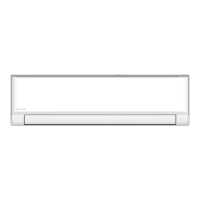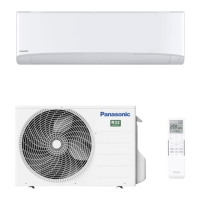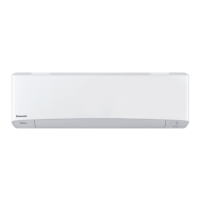
Do you have a question about the Panasonic CS-Z50XKRW-1 and is the answer not in the manual?
| Cooling Capacity | 5.0 kW |
|---|---|
| Heating Capacity | 6.0 kW |
| Power Supply | 220-240V, 50Hz |
| Refrigerant | R32 |
| Energy Efficiency Class (Cooling) | A++ |
| Energy Efficiency Class (Heating) | A++ |
| Type | Split System |
| Seasonal Energy Efficiency Ratio (SEER) | 6.10 |
| Noise Level (Outdoor) | 50 dB(A) |
Provides a quick overview of essential setup and initial operations.
Step-by-step instructions for inserting batteries into the remote control.
Guide on how to set the current time on the remote control for accurate operation.
Covers fundamental controls for starting, stopping, and mode selection.
Instructions on powering the unit on and off using the remote control.
How to choose between various operating modes like COOL, HEAT, DRY, FAN.
Guide to setting the desired temperature and switching units (°C/°F).
Covers hazard warnings, symbols, and safety for units and remote control.
Safety guidelines for electrical connections and R32 refrigerant handling.
Essential safety measures for unit installation and professional servicing.
Procedures for detecting leaks and performing electrical safety checks.
Safety for repairing components, cabling, and refrigerant recovery.
Safe practices for charging refrigerant and decommissioning the unit.
Requirements for equipment labelling and safe refrigerant management.
Instructions for controlling the direction of air circulation.
How to adjust fan speed for comfort and low noise levels.
Activating the nanoe X function for air purification and humidification.
Switching between POWERFUL and ECO modes for performance or energy saving.
Using iAUTO-X for faster cooling by adjusting temperature and fan speed.
Setting the sleep timer for comfortable night-time use.
Information on setting up wireless LAN module operation.
Programming ON and OFF timers for automatic unit operation.
Details on recommended operating temperatures for different modes.
Tips for energy saving and specific airflow adjustments in various modes.
How the unit resumes operation after a power failure.
Instructions for cleaning the indoor unit, including front panel and coils.
Steps for cleaning the outdoor unit exterior and air filters.
Explains common operational behaviours that are not malfunctions.
Essential checks to perform before contacting a service technician.
Troubleshooting steps for problems with the remote control and unit indicators.
Guidelines for seasonal inspection and preparing for extended periods of non-use.
Steps to access and interpret error codes displayed by the unit.
Guidance on recycling old equipment and batteries according to regulations.
Explanations of symbols related to refrigerant and service personnel.












